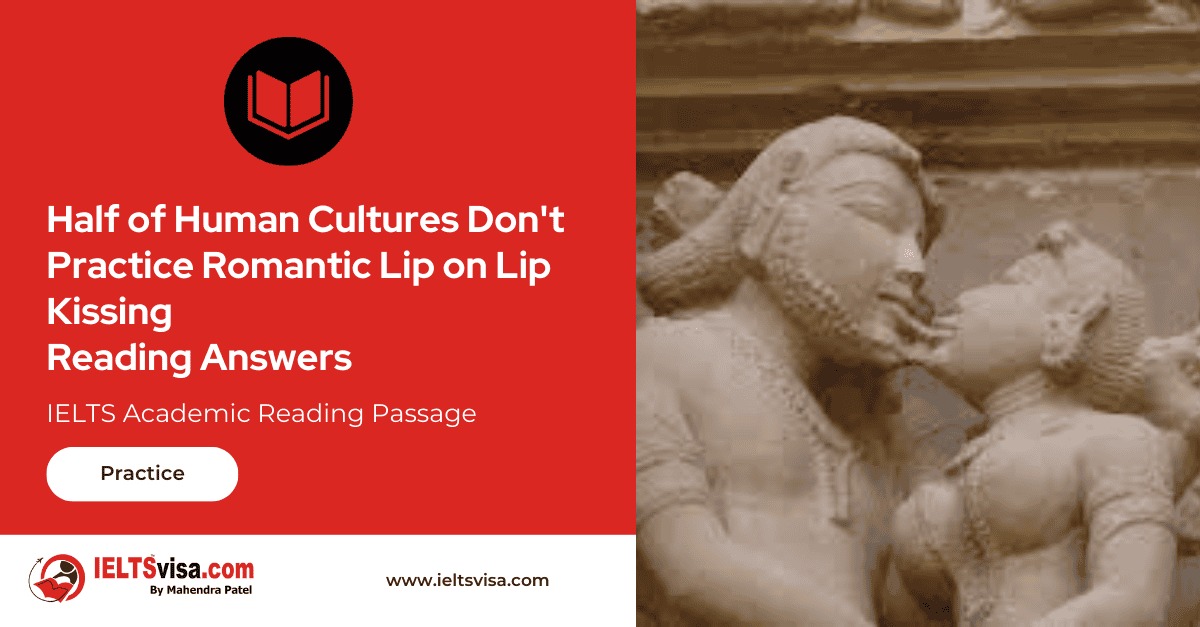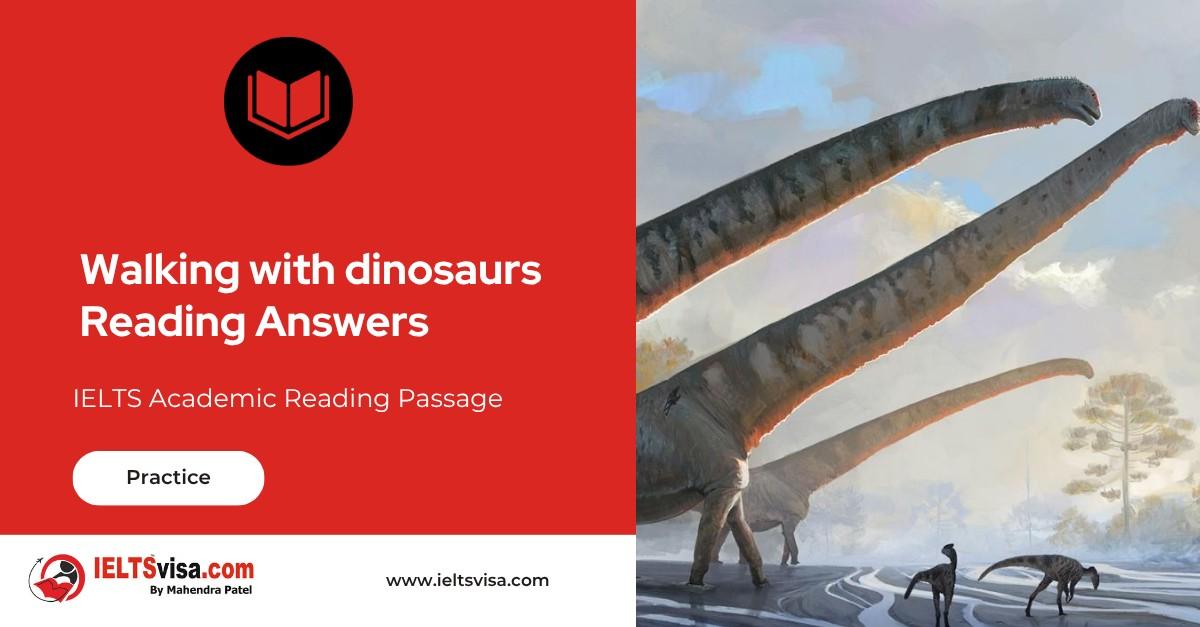Half of Human Cultures Don't Practice Romantic Lip on Lip Kissing Reading Answer
IELTS Academic Reading Passage
When you think about it, kissing is strange and a bit icky. You share saliva with someone, sometimes for a prolonged period of time. One kiss could pass on 80 million bacteria, not all of them good. Yet everyone surely remembers their first kiss, in all its embarrassing or delightful detail, and kissing continues to play a big role in new romances. At least, it does in some societies. People in western societies may assume that romantic kissing is a universal human behaviour, but a new analysis suggests that less than half of all cultures actually do it. Kissing is also extremely rare in the animal kingdom.
Previous estimates had put the figure at 90%. The new study excluded parents kissing their children, and focused solely on romantic lip-on-lip action between couples. So what’s really behind this odd behaviour? If it is useful, why don’t all animals do it – and all humans too? It turns out that the very fact that most animals don’t kiss helps explain why some do. According to a new study of kissing preferences, which looked at 168 cultures from around the world, only 46% of cultures kiss in the romantic sense.
Previous estimates had put the figure at 90%. The new study excluded parents kissing their children, and focused solely on romantic lip-on-lip action between couples.
Many hunter-gatherer groups showed no evidence of kissing or desire to do so. Some even considered it revolting. The Mehinaku tribe in Brazil reportedly said it was “gross”. Given that hunter-gatherer groups are the closest modern humansget to living our ancestral lifestyle, our ancestors may not have been kissing either. The study overturns the belief that romantic kissing is a near-universal human behaviour, says lead author William Jankowiak of the University of Nevada in Las Vegas. Instead it seems to be a product of western societies, passed on from one generation to the next, he says. There is some historical evidence to back that up.
Kissing as we do it today seems to be a fairly recent invention, says Rafael Wlodarski of the University of Oxford in the UK. He has trawled through records to find evidence of how kissing has changed. The oldest evidence of a kissing-type behaviour comes from Hindu Vedic Sanskrit texts from over 3,500 years ago. Kissing was described as inhaling each other’s soul. In contrast, Egyptian hieroglyphics picture people close to each other rather than pressing their lips together. So what is going on? Is kissing something we do naturally, but that some cultures have suppressed? Or is it something modern humans have invented? We can find some insight by looking at animals.
Our closest relatives, chimpanzees and bonobos, do kiss. Primatologist Frans de Waal of Emory University in Atlanta, Georgia, has seen many instances of chimps kissing and hugging after conflict. For chimpanzees, kissing is a form of reconciliation. It is more common among males than females. In other words, it is not a romantic behaviour. Their cousins the bonobos kiss more often, and they often use tongues while doing so. That’s perhaps not surprising, because bonobos are highly sexual beings. When two humans meet, we might shake hands. Bonobos have sex: the so-called bonobo handshake. They also use sex for many other kinds of bonding. So their kisses are not particularly romantic, either.
These two apes are exceptions. As far as we know, other animals do not kiss at all. They may nuzzle or touch their faces together, but even those that have lips don’t share saliva or purse and smack their lips together. They don’t need to. Take wild boars. Males produce a pungent smell that females find extremely attractive. The key chemical is a pheromone called androstenone that triggers the females’ desire to mate. From a female’s point of view this is a good thing, because males with the most androstonene are also the most fertile. Her sense of smell is so acute, she doesn’t need to get close enough to kiss the male.
The same is true of many other mammals. For example, female hamsters emit a pheromone that gets males very excited. Mice follow similar chemical traces to help them find partners that are genetically different, minimising the risk of accidental incest. Animals often release these pheromones in their urine. “Their urine is much more pungent,” says Wlodarski. “If there’s urine present in the environment they can assess compatibility through that.”
It’s not just mammals that have a great sense of smell. A male black widow spider can smell pheromones produced by a female that tell him if she has recently eaten. To minimise the risk of being eaten, he will only mate with her if she is not hungry. The point is, animals do not need to get close to each other to smell out a good potential mate. On the other hand, humans have an atrocious sense of smell, so we benefit from getting close. Smell isn’t the only cue we use to assess each other’s fitness, but studies have shown that it plays an important role in mate choice. A study published in 1995 showed that women, just like mice, prefer the smell of men who are genetically different from them. This makes sense, as mating with someone with different genes is likely to produce healthy offspring. Kissing is a great way to get close enough to sniff out your partner’s genes.
In 2013, Wlodarski examined kissing preferences in detail. He asked several hundred people what was most important when kissing someone. How they smelled featured highly, and the importance of smell increased when women were most fertile. It turns out that men also make a version of the pheromone that female boars find attractive. It is present in male sweat, and when women are exposed to it their arousal levels increase slightly. Pheromones are a big part of how mammals chose a mate, says Wlodarski, and we share some of them. “We’ve inherited all of our biology from mammals, we’ve just added extra things through evolutionary time.”
On that view, kissing is just a culturally acceptable way to get close enough to another person to detect their pheromones. In some cultures, this sniffing behaviour turned into physical lip contact. It’s hard to pinpoint when this happened, but both serve the same purpose, says Wlodarski. So if you want to find a perfect match, you could forego kissing and start smelling people instead. You’ll find just as good a partner, and you won’t get half as many germs. Be prepared for some funny looks, though.
Questions 31-35
Do the following statements agree with the information in the IELTS reading text?
In boxes 28-32 on your answer sheet, write
TRUE – if the statement agrees with the information
FALSE – if the statement contradicts the information
NOT GIVEN – if there is no information on this
31. Both Easter and Wester societies presume that kissing is essential for any part of the world.
32. Our ancestors were not likely to kiss.
33. Chimpanzees and bonobos kiss not for the romance.
34. There are other animal, rather than apes, that kiss.
35. Scent might be important in choosing your partner.
Questions 36-39
Write NO MORE THAN TWO WORDS from the passage for each answer.
36. According to the Mehinaku tribe, kissing is……….
37. Human tradition is……………………when they meet.
38. A male black widow will mate with the female if only she is……….
39. Humans benefit from getting close due to the fact that we have an…….. of smell.
Question 40
Choose the correct letter, A, B, C or D.
40. Passage 3 can be described as:
- Strictly scientific text
- Historical article
- Article from a magazine
- Dystopian sketch

Solution For: Half of Human Cultures Don’t Practice Romantic Lip on Lip Kissing
Reading Answer
| 31. FALSE | 32. TRUE |
|---|---|
| 33. TRUE | 34. FALSE |
| 35. TRUE | 36. gross |
| 37. shake hands | 38. not hungry |
| 39. atrocious sense | 40. C |
Review and Practice
- Regularly practice with IELTS reading samples and time yourself to get used to the pressure of the exam.
- Review your mistakes to understand where you went wrong and how to avoid similar errors in the future.
Our Books
Master IELTS Speaking Part 1
IELTS Writing Task 1 Book
IELTS Writing Task 2 Book
Half of Human Cultures Don't Practice Romantic Lip on Lip Kissing Reading Answer Explanation
Comin Soon
Practice IELTS Other Modules
IELTS Listening
The IELTS Listening test assesses how well you can understand spoken English in various contexts. It lasts about 30 minutes and is divided into four sections with a total of 40 questions. The listening tasks become increasingly difficult as the test progresses.
IELTS Academic Reading
The IELTS Academic Reading section assesses your ability to understand and interpret a variety of texts in academic settings. It is designed to evaluate a range of reading skills, including skimming for gist, reading for main ideas, reading for detail, understanding inferences, and recognizing a writer's opinions and arguments.
IELTS Speaking
The IELTS Speaking test assesses your ability to communicate in English on everyday topics. It lasts 11-14 minutes and consists of three parts: introduction, cue card, and a discussion based on the cue card topic.
IELTS General Reading
IELTS General Reading tests your ability to understand and interpret various types of texts. Here are some key areas and types of content you can expect to encounter in the reading section, along with tips for effective preparation.
IELTS Academic Writing Task 1
In IELTS Academic Writing Task 1, you are presented with a visual representation of information, such as graphs, charts, tables, or diagrams, and you are required to summarize, compare, or explain the data in your own words.
IELTS General Writing Task 1
In IELTS General Writing Task 1, you are required to write a letter based on a given situation. The letter can be formal, semi-formal, or informal, depending on the prompt. Here’s a breakdown of the key components to include in your letter
IELTS Academic Writing Task 2
In IELTS Academic Writing Task 2, you are required to write an essay in response to a question or topic. Here’s a guide to help you understand the essential elements of this task
IELTS Exam Tips
To succeed in the IELTS exam, practice regularly, familiarize yourself with the test format, improve your vocabulary, develop time management skills, and take mock tests to build confidence.
Grammer for IELTS
Grammar is the foundation of effective communication in English. Understanding tense usage, subject-verb agreement, and sentence structure enhances clarity and coherence in writing and speaking.
Vocabulary for IELTS
Vocabulary plays a crucial role in the IELTS (International English Language Testing System) exam, especially in the Speaking and Writing sections. Here’s an overview of why vocabulary is important and how it impacts your performance
RECENT IELTS SAMPLES QUESTIONS AND ANSWERS
Walking with dinosaurs
Peter L. Falkingham and his colleagues at Manchester University are developing techniques that...
Money as the Unit of Amount Reading Answers
The most difficult aspect of money to understand is its function as a unit of account. In...
WEATHERING IN THE DESERT
In the deserts, as elsewhere, rocks at the earth's surface are changed by weathering, which...
Nature on Display in American Zoos
The first zoo in the United States opened in Philadelphia in 1874, followed by the Cincinnati...
Can We Prevent the Poles From Melting
Such is our dependence on fossil fuels, and such is the volume of carbon dioxide we have...
Air conditioning the earth reading answers
The circulation of air in the atmosphere is activated by convection, the transference of heat...













